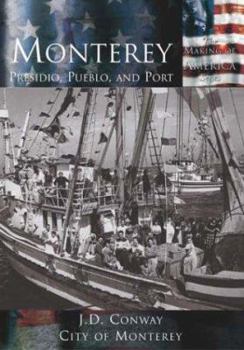Monterey:: Presidio, Pueblo and Port
Select Format
Select Condition 
Book Overview
Monterey, California conjures images of a coastal city rimmed by crystal clear waters and bolstered by tourism; yet these edenic views belie the community's often turbulent history, originating with... This description may be from another edition of this product.
Format:Paperback
Language:English
ISBN:0738524239
ISBN13:9780738524238
Release Date:June 2003
Publisher:Arcadia Publishing (SC)
Length:160 Pages
Weight:0.95 lbs.
Dimensions:0.5" x 6.7" x 9.9"
Customer Reviews
2 ratings
Conway demonstrates an impeccable scholarship of the subject area
Published by Thriftbooks.com User , 18 years ago
From its opening pages, Jim Conway's Monterey: Presidio, Pueblo and Port demonstrates an impeccable scholarship of the subject area that will no doubt prove to be an important contribution to our understanding of the history of Monterey, California. According to Conway, the history of Monterey is more than a mere categorizing of its history into four periods- Indigenous, Spanish, Californio and American, but rather this seaside picturesque community developed as a result of its cultures derived from Native People to its current inhabitants. Today, people come to Monterey to vacation and experience the splendor of its natural surroundings. Conway explores how Monterey has reached this interval in its history as it grew from a Presidio to a Pueblo and into a Port. It is a story that comes from real places and people where cultural conflict and historical tolerance played a significant role. The book is organized in a concrete and logical manner with the first chapter focused on Monterey's natural history and its original inhabitants, the Rumsien Oholone. According to Conway, "to understand Monterey it is important to start with its natural history, because not matter what man has endeavored to accomplish, it is the weather patterns and topography that ultimately fashioned Monterey." It was Monterey's native people who depended most on the indigenous trees, grasses and plants in their daily lives, as well as the changing seasons. As pointed out, O'chons was the word for "seed times," and these Native Americans measured time not by a calendar but rather by the natural events that made up their seasons, as they considered themselves to be a part of nature. Not very much is known about these Native Americans, as their story was told by Euro-Americans, and as many of us are aware, historians have constantly debated among themselves how to differentiate the ultimate "facts" and "objective truth." Although, the Spanish were the first to keep written records of the native people, unfortunately, there seems to be an absence of the stories and interpretations of the losers in the battle-the natives themselves. From this interesting opening chapter, Conway proceeds to explore the contributions of the Spanish settlers and missionaries, however, as he points out, prior to the arrival of these individuals, Monterey bay was visited and promoted by Spanish explorers and fortune seekers. Considerable ink is given to who these adventurers were and the role they played in the history of Monterey. One such important figure that we read about is Rodriguez Cabrillo's and his expedition in 1542 and as we are informed it was his expedition that helped to identify and map the coastline of California. Moreover, his discovery of the San Diego and Monterey Bays brought further exploration, which ultimately led to the first European settlements in Alta California. These first European settlers were soldiers and missionaries who had arrived with Gaspar de Portola and Fath
excellent narrative history of Monterey
Published by Thriftbooks.com User , 19 years ago
J.D. Conway integrates an enormous amount of archival material, established work, and new history into a readable, fascinating account of Monterey, California from its earliest Native American settlement to the present. He does a particularly good job here of gender analysis throughout, as well as highlighting contributions to Monterey history on the part of diverse ethnicities.The text is extremely well written and fun to read.





